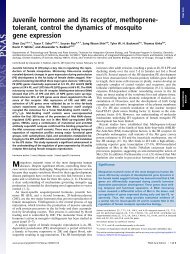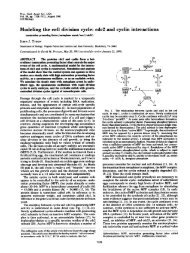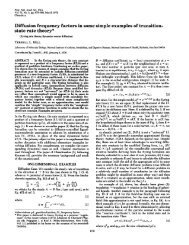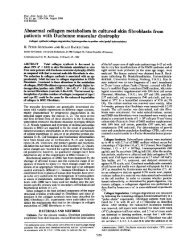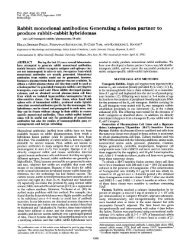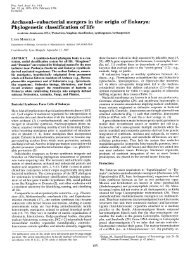Supporting Information (SI) Appendix - Proceedings of the National ...
Supporting Information (SI) Appendix - Proceedings of the National ...
Supporting Information (SI) Appendix - Proceedings of the National ...
Create successful ePaper yourself
Turn your PDF publications into a flip-book with our unique Google optimized e-Paper software.
with very few exceptions. Sampling was carried out during bloom, so it was possible to verify<br />
<strong>the</strong> flower sex. Moreover, <strong>the</strong>y ensured that <strong>the</strong> sylvestris samples did not come from<br />
populations growing adjacent to present-day vineyards or land known to be previously planted<br />
with vinifera. We note, however, that despite <strong>the</strong> use <strong>of</strong> <strong>the</strong>se criteria, it is impossible to rule out<br />
<strong>the</strong> possibility <strong>of</strong> influence from cultivated vines. All sampling locations were at an altitude <strong>of</strong><br />
0-500m with environmental conditions typical for sylvestris: wetlands and forests with high<br />
humidity, as well as <strong>the</strong> frequent presence <strong>of</strong> tree species such as elm, poplar, hawthorn,<br />
hornbeam and oak on which sylvestris grow as lianas. Ed Stover also used similar standard<br />
criteria and ensured that <strong>the</strong> 9 samples used here from Armenia and Georgia did not come from<br />
populations growing adjacent to present-day vineyards or land known to be previously planted<br />
with vinifera. Dr Stover collected samples in October and <strong>the</strong>refore could not confirm flower<br />
sex. However, <strong>the</strong> vast majority <strong>of</strong> <strong>the</strong> vines was not bearing fruit and was <strong>the</strong>refore presumably<br />
male. It is worth noting that results are at least consistent across sampling expeditions: samples<br />
collected from similar geographic locations on different expeditions generally cluster toge<strong>the</strong>r in<br />
PC space (Figure 4, Figures S7-S9).<br />
It is impossible to claim with absolute certainty that <strong>the</strong> samples we identify as sylvestris are<br />
truly wild samples with no genetic input from cultivated grapevines. This is <strong>the</strong> case for any<br />
study that makes use <strong>of</strong> sylvestris samples [e.g. 8,9]. While it is most common to make use <strong>of</strong><br />
morphological criteria exclusively, here we enhance <strong>the</strong> morphological criteria we have used to<br />
identify sylvestris with genetic analyses.<br />
To provide a visualization <strong>of</strong> <strong>the</strong> relationships among all <strong>of</strong> <strong>the</strong> samples used in <strong>the</strong> present<br />
study, a PCA plot was generated using <strong>the</strong> 2958 LD-pruned SNPs on <strong>the</strong> set <strong>of</strong> unique vinifera<br />
and sylvestris samples (Figure S7). Figure S7 shows that <strong>the</strong>re is one exceptional sample,<br />
indicated with an arrow, that is labeled as vinifera but clearly clusters among <strong>the</strong> western<br />
sylvestris. This sample was donated to <strong>the</strong> USDA collection in 1983 by Dr Harold Olmo and is<br />
labeled in GRIN as “Beli Potok” (DVIT 1841), a female vine likely <strong>of</strong> Serbian origin with<br />
morphological characteristics that are consistent with it being sylvestris. Olmo’s “wild vinifera”<br />
samples, indicated by black dots in Figure S7, are discussed below. From Figure S7, it is<br />
apparent that <strong>the</strong> western sylvestris are relatively distinct and pull out along both PC1 and PC2.





